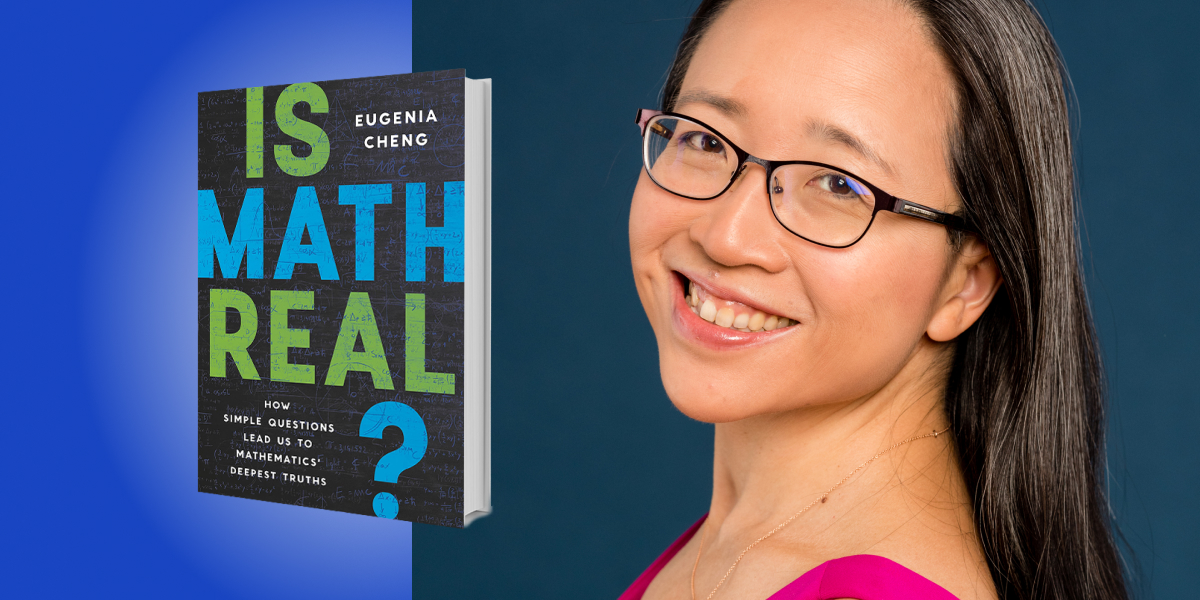Dr. Eugenia Cheng is a mathematician, educator, and pianist. She is Scientist in Residence at the School of the Art Institute of Chicago, where she teaches abstract mathematics to undergraduate art students. She is also Honorary Visiting Fellow at City, University of London.
Below, Eugenia shares 5 key insights from her new book, Is Math Real?: How Simple Questions Lead Us to Mathematics’ Deepest Truths. Listen to the audio version—read by Eugenia herself—in the Next Big Idea App.

1. Math might seem like it’s about answers, but an important part is about asking questions.
This is how math has kept developing across history: by people asking more and more questions, and not being satisfied with superficial answers. The questions might seem innocent, naive, vague, or philosophical, but any question stemming from curiosity, confusion, scepticism, or even disbelief can lead to deep mathematics.
I don’t mean questions like “What’s 84 times 107?” I mean questions like: Why does 1+1=2? Why can’t we divide by zero? What is zero? What are numbers? Where does math come from? How do we know math is right? How do we know math is real? Is math real?
Often in research, math is not about getting the right answers to things, but about asking why something is happening, or in what context something is true. One plus one is often two but there are also situations in which something else happens. If you mix one color of paint with one other color of paint, you get one new color of paint, not two colors. If you turn a piece of paper over and turn it over again you get back to where you started, so in a sense, one plus one leads you to zero. If someone impatiently presses the button for the elevator after you’ve already pressed it, nothing new happens: you don’t call two elevators.
“We don’t like just being told that things are true.”
These aren’t the sorts of scenarios that usually come up in math class or in math tests, but they’re all interesting mathematical ideas. They have fancy mathematical names like “the cyclic group of order two” or “idempotents” or “binary operations”, but you don’t need to know that in order to think about paint or elevator buttons.
In fact, it turns out that the questions research mathematicians care about are often the same questions asked by people who think of themselves as “not math people.” Research mathematicians and math-phobic people have many attitudes in common; we don’t think math is obvious, we don’t like just being told that things are true, and we don’t want to have to memorize answers to anything.
2. Counting with blocks is really profound.
It might seem that counting with blocks is just something children have to do before they can do mental arithmetic. And that once you can do mental arithmetic you don’t need blocks anymore. But the thing is, doing arithmetic with blocks can lead us to think more deeply about why things are true, and this leads to some very profound math that’s part of my research.
Take addition for example. You can demonstrate two plus three equals five by lining up two blocks and then three and counting the total. Then you can slide the two blocks around the three blocks to show that three plus two gives the same answer. This is called the commutativity of addition.
Some people might say it’s “obvious” that two plus three is equal to three plus two. But it’s quite deep. What we did with blocks is actually a two-dimensional argument, because you had to be in at least two-dimensional space to slide those blocks around each other. If you were counting on an abacus instead, the beads would be stuck in one dimension on a rail and you wouldn’t be able to do that sliding-around thing, to demonstrate commutativity.
Moreover, there are two different ways to demonstrate it: You could slide the two blocks around the top of the three to get to the other side, or around the bottom. Are those related? Actually, we live in three dimensions so we could just pick the blocks off the table and put them down on the other side. What if we were in four dimensions? These are important questions in the understanding of higher-dimensional space, and in the research field of higher-dimensional category theory. You’d never get to those questions by just declaring that two plus three equaling three plus two is “obvious.” You get there by asking why it’s true.
Children can ask very simple sounding questions that are actually very hard to answer and don’t have clear answers. This makes it quite unnerving teaching math because even a five-year-old can ask a question that you can’t answer. Even if you can answer it, it needs research-level math to do it.
3. It doesn’t matter whether math is real or not, it’s still helpful.
Math is often not about what the answer is, and not even about why something is the answer, but in what context something is the answer. Or in what sense something could be the answer. There can be many different answers, and the point is not which one is best, but in what ways the different answers help us.
For example: Is math real? Well, first we need to ask ourselves what “real” even means. Is anything real? Am I real? What are we actually asking here?
Math is a framework for studying ideas and thought processes. Are ideas and thought processes real? In a sense, they’re not, because we can just dream them up out of nowhere. But those are still real ideas. In a way, it doesn’t matter if you count an idea as real or not, just as it doesn’t really matter whether I think I’m real or not: I will keep getting on with my life. What’s important is whether math helps us or not. I, for one, think it does.
“I learned more about the dangers of debt by reading Madame Bovary than by learning about compound interest.”
Let’s not dismiss math as irrelevant just because it’s “made up.” Fiction is also “made up” but can give us real insight into life. I learned more about women’s exclusion from society by reading Jane Austen than by studying statistics. I learned more about the dangers of debt by reading Madame Bovary than by learning about compound interest, although understanding compound interest also helped.
Math may or may not be just “made up,” but either way that’s not the point. The point is that it gives us real insights into life. It helps us with things like science, medicine, engineering, and technology.
Even if you’re never going to work in those fields, math can still help you understand the world around you better. It even helps me understand political arguments, detect when people are trying to manipulate me, and empathize with other people because I can understand their arguments from their point of view.
4. I don’t know how many holes a straw has.
You might have missed this, but periodically an argument rages on the internet (no, surely not) about how many holes a straw has. Because it’s the internet, the argument degenerates into people telling each other how dumb they are because obviously a straw has two holes. Or obviously, it has one.
People periodically ask for my take on this because it does sort of turn into math. But unfortunately, when things are about math on the internet, all too often it’s just an excuse for people to be derogatory about other people’s intelligence.
That’s not what math should be about. Math is about shedding light and finding different senses in which different things are true. Mathematically, I can argue that a straw has one hole. I can also argue that it has two holes. I could also argue that it has zero holes, or infinite holes. Investigating those different answers is much more interesting to me than trying to claim one answer is right and the others are wrong. And some interesting math comes into it.
The mathematical field of topology studies the shapes of things and imagines that everything is made of something soft and squashy, like Play-Doh. If you were going to make a straw out of Play-Doh, you could do it by taking a blob of Play-Doh, poking a hole in it—one hole—and then elongating the result into a straw. So, a straw has one hole!
But then why does it look like there’s a hole at each end? Well, in the mathematical field of manifolds, we think about surfaces and their boundaries. A straw has two boundary circles, one at each end, so in that sense, it has two holes.
Neither answer is right, or wrong, but they both involve interesting and deep mathematics.
5. The typical math curriculum puts many people off math without achieving enough to outweigh that negative outcome.
The typical math curriculum is all heading to standardized tests, and it doesn’t leave space for people to ask curious, open-ended questions. It should. It’s not the fault of teachers who are under pressure just to teach pre-set requirements. It’s a problem with whole the system.
Many people were so put off by math at school that they’ve forgotten everything they learned. They shudder with horror at the very idea of doing anything mathematical. They then feel stupid about that aspect of their abilities forever. People often say to me “I’m terrible at math” either defensively or even proudly, or they resign themselves to “not being a math person.” This is a really sad outcome.
“Too many adults are afraid of math or have a resistance to it.”
But I sympathize with this attitude because I used to do that with sports. I was put off all sports at school, and I used to say “I’m terrible at sports”—defensively, or even proudly. I resigned myself to being unfit and terrible at anything to do with a ball. Eventually, though, I got over that once I found some things I could do just for me, where nobody else would be judging or humiliating me. I’m more fit and healthy, and also have a lot of fun!
Too many adults are afraid of math or have a resistance to it. They have mental block and freeze around anything mathematical. This makes for confusion around important scientific concepts that affect society, like a pandemic, climate change, compound interest and debt. Moreover, it makes it easier for people to be misled and manipulated by politicians or the media or random internet celebrities.
If that’s the outcome of math education then I think it was worse than pointless. Perhaps the pain would be worth it if some lasting skills were learned anyway, but if someone gets no lasting skills from it, and plenty of lasting pain, it’s the worst of both worlds.
I hope we can stop making people feel bad about math. I hope we can validate everyone’s questions and try to answer them as best we can instead of making them feel stupid for asking them.
To listen to the audio version read by author Eugenia Cheng, download the Next Big Idea App today:
































